Bad Optics: Managing Perception in Pakistani Politics
Based on Muna Khan’s editorial in Dawn, published September 8, 2025
Executive Summary
Perception plays a decisive role in modern politics. Even well-intentioned actions can erode credibility when presented poorly or timed insensitively. In Pakistan, recent criticism surrounding Maryam Nawaz’s official visit to Japan demonstrates the dangers of “bad optics.” While international engagement is vital, the trip’s promotion overshadowed substantive outcomes, invited gendered criticism, and appeared tone-deaf against the backdrop of catastrophic floods at home.
This report analyzes how political optics intersect with gender, governance, and public sentiment. It highlights lessons from international examples, particularly Indonesia, and concludes with policy recommendations aimed at building political credibility through responsible communication, empathetic leadership, and strategic media management.
1. Introduction
In democratic societies, governance outcomes and public perception are interdependent. Leaders must not only make effective policy decisions but also communicate them in a manner that resonates with citizens. Optics — the way events, initiatives, and personalities are framed — can strengthen or undermine legitimacy. In fragile democracies, poor optics risk delegitimizing leadership entirely.
2. Context: Maryam Nawaz’s Japan Visit
-
Nature of the Trip: Aimed at strengthening diplomatic and cultural ties.
-
Optics Controversy: Media coverage focused less on the visit’s achievements and more on its lavish presentation, entourage size, and expensive advertisements.
-
Timing: The visit coincided with severe flooding in Pakistan, intensifying criticism that leaders were disconnected from public suffering.
-
Gendered Reaction: The intensity of backlash reflected deep societal misogyny — women leaders are scrutinized more harshly for actions men often undertake without equivalent criticism.
3. Analytical Dimensions
3.1 Optics vs. Substance
-
Policy outcomes can be overshadowed when presentation appears elitist.
-
Substance (international diplomacy) was eclipsed by perceptions of extravagance and tone-deafness.
3.2 Gender and Political Optics
-
Women in leadership positions face disproportionate criticism for missteps.
-
The framing of Maryam’s trip highlights the intersection of optics with entrenched gender biases.
3.3 Youth Perception and Engagement
-
Younger demographics are increasingly resistant to traditional political image-building.
-
The youth prioritize impact over projection; promotional campaigns and vlogs often appear out of touch, even “cringe.”
3.4 International Parallel: Indonesia
-
In Indonesia, protests erupted in 2024 after MPs granted themselves lavish allowances during economic hardship.
-
Lesson: Tone-deaf policies and optics can provoke unrest, compelling governments to retract privileges.

4. Risks of Mismanaged Optics
-
Erosion of Trust: Citizens perceive disconnect between rulers and lived realities.
-
Political Polarization: Elites appear self-serving, fueling opposition narratives.
-
Youth Disillusionment: Failure to connect with younger generations accelerates political disengagement and emigration.
-
International Repercussions: Poorly presented diplomacy weakens credibility abroad.
5. Policy Recommendations
-
Strategic Communication Framework
-
Establish media guidelines for political visits and public campaigns.
-
Prioritize substance over spectacle in official messaging.
-
-
Empathy-Centered Leadership
-
Align communication strategies with prevailing domestic realities (e.g., avoid extravagance during natural disasters).
-
Integrate humanitarian outreach into official trips.
-
-
Gender-Sensitive Political Training
-
Provide support to women politicians to counter gendered backlash.
-
Promote equal scrutiny standards in media reporting.
-
-
Youth-Focused Engagement
-
Replace vanity projects with participatory initiatives for students, entrepreneurs, and young professionals.
-
Expand platforms for youth input into governance.
-
-
Institutional Oversight
-
Parliamentary committees should review expenses for international trips.
-
Transparency in reporting trip costs and outcomes can mitigate misinformation.
-
6. Vocabulary & Key Concepts
| Term | Definition |
|---|---|
| Political optics | The way actions and decisions are perceived by the public. |
| Gendered backlash | Disproportionate criticism of women leaders due to entrenched biases. |
| Tone-deaf leadership | Political actions perceived as insensitive to citizens’ hardships. |
| Political capital | Trust and legitimacy that leaders can draw upon to pursue policies. |
| Youth disillusionment | Disengagement of younger populations from politics due to unmet expectations. |
| Strategic communication | Coordinated messaging to align intent with public perception. |
7. Conclusion
In Pakistan, the politics of perception increasingly shape outcomes as much as policy. Maryam Nawaz’s Japan trip underscores the reality that leaders cannot afford to ignore optics, especially in times of national crisis. Poorly managed narratives invite backlash, intensify gendered attacks, and deepen youth alienation.
The path forward requires empathetic leadership, transparent communication, and institutionalized checks. By aligning optics with substance, Pakistan’s political class can build the trust necessary to navigate crises, strengthen democracy, and engage a disillusioned citizenry.

